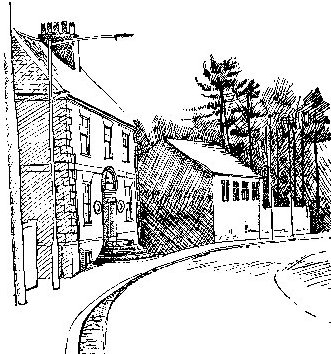Thursday 9th of May 2024
Thursday 9th of May 2024

The Great House was built in 1698 for members of an old Kegworth family, the Suttons.
Architecturally it is an important house, since it belongs to a short period in English architecture, that of William and Mary. The seventeenth century was important in England in many ways since it marks the transition from the old rather primitive medieval ways of house - building, social conditions, education etc., to a more sophisticated and richer way of life initiated by The Revival of Learning, called the Renaissance in Italy in the sixteenth century; the decrease in the power of religion and the rise of humanism or the realisation of man's potential as a thinking and rational human being.
This can be seen in the transition from the uncomplicated timber frame houses of the Tudor and Stuart period to the grander brick built and well - designed Georgian houses, two examples of which we have very near to each other in Kegworth and within a stones throw from the Church.
The Great House itself marks a transition between these two. It owes its design to Dutch influence, for William of Orange came from Holland to become King with Mary Stuart as Queen and he brought with him a new style in architecture, a love of tulips and pug dogs, all of which inhabit the Great House.
If one visits the Hague in Holland, many similar examples can be seen typifying the Dutch love of squares, rectangles and order in buildings as in gardens and many other things. Very few houses of this period exist in the country, Risley boasts a fine example, the shell only unfortunately, since the interior has been modernised, another in Leicestershire and ours in Kegworth, which has a fine Swithland Slate roof of graduated green slates. The semicircular steps are a feature of the house and before the level of the A6 road rose, there were more. Similarly, the basement was originally the ground floor, where kitchens and pantries existed and the rooms opening off the entrance hall were the reception rooms, a pattern later followed in most eighteenth century Georgian town and village houses.
But this late seventeenth century house is only one of a series of buildings on this ancient site, Excavations in the cellar have revealed the bases of pillars which supported a structure of the Roman period and a large domed kiln, whose stone Gothic door denotes a date sometime in the twelfth or thirteenth century. So with this history of multiple occupation it is not surprising that there is a history of multiple hauntings.
"Presences", seen either as fleeting figures, gone in the wink of an eye, or recognisable people, such as the large elderly lady, dressed in grey tweeds, seen walking towards the garden wall where formally there was a gate. Perhaps it was the same lady (dead only a few decades ago) whose footsteps are quite often heard by several people, walking as if on a flat surface, where there is now gravel. Also the same curious lady and one of forceful character, so one is told, insisted on raising the latch of the door connecting kitchen and sitting room. All very interesting although draughty on cold winter evenings, but when told to go in no uncertain terms, the latch lifting person duly departs. The presence is not malign or evil in any way, but merely curious I feel and really fully entitled to visit the house in which she once lived.
Different again are the distant sounds of conversation, just discernible but unintelligible and the occasional whiffs of cigarette smoke, when no one around is smoking. More disturbing are the rare evidences of a mischievous poltergeist, heavy objects moved several inches from their normal position and mundane objects like soap flake packets literally jumping around under ones eyes.
Peaceful manifestations include an old man sitting in a very high backed wing chair in front of a roaring fire, interesting since no fire has been lit in that fireplace for many years. All of these happenings indicate that the former owners formed an intense devotion to the house, one which is parallelled by the present inhabitants.
Christine McKay.
